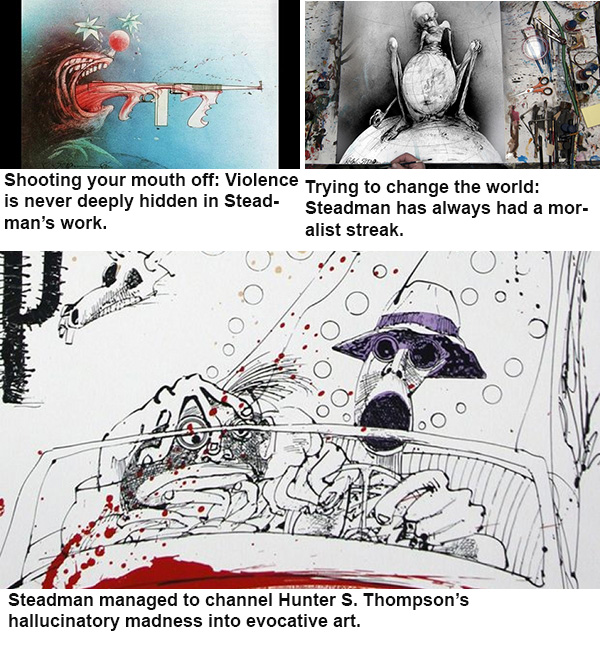The other side of Gonzo
You’ve seen Ralph Steadman’s art decorating ‘Fear and Loathing in Las Vegas.’ It’s a savage style: part Jackson Pollock, part Francis Bacon, part Zapruder film, Steadman’s images reveal the dark side of Edge City.
At one point during the documentary For No Good Reason, narrator Johnny Depp asks illustrator Ralph Steadman about his relationship with Hunter S. Thompson, the writer whose books he decorated with such explosive artwork. “He could be a real son of a bitch,” Steadman, an Englishman, cautiously allows. As though this wasn’t already common knowledge.
Thompson was also Steadman’s partner in gonzo madness, at a time when the borders of journalism were being blown apart as decisively as one of Steadman’s ink-splattered creations. You’ve seen his art on the cover of Fear and Loathing in Las Vegas, the posters of Withnail and I: it’s a disarmingly savage style that has crept into modern consciousness. Part Jackson Pollock, part Francis Bacon, part Zapruder film, Steadman’s images reveal the dark side of Edge City.
Yet in For No Good Reason, Depp returns to familiar territory: his pal Thompson blew his brains out in 2006, and this documentary feels like a revisit to a subject that still haunts the actor, or at least continues to resonate for him. Depp stands around Steadman’s studio, somewhere in England, watching the artist create before the camera: it’s a fascinating process, usually started with a few deft flicks of India ink on a large sheet of Cartilage paper. Depp is decked out in sunglasses, a wide-brimmed floppy hat, wearing wristbands and studs, puffing a hand-rolled cigarette; perhaps even he’s not aware that he’s “in character,” dressed like Hunter’s stand-in.
The documentary is as scattershot as one of Steadman’s compositions, but we learn much more about what led a mild-mannered English illustrator to come to America and absorb all of its mayhem. Steadman was a well-regarded cartoonist for British publications back in 1969, but he recognized there was something missing from his work until he met Thompson: a certain “rawness.”
The gonzo journalist brought that to the table when the two were paired up for a magazine assignment: cover the Kentucky Derby; Ralph will make sketches, Hunter will take notes. The resulting piece, published in 1969 (“The Kentucky Derby Is Decadent and Depraved”), pretty much birthed a style of reporting that became known ultimately, and tediously, as “gonzo journalism.” The tenets were Hunter’s:
1. Find your story.
2. Immerse yourself in it.
3. BECOME THE STORY.
Further assignments together — driving to Las Vegas to find “the American Dream,” coverage of the 1972 campaign trail, a visit to Zaire to cover the Ali-Frazier fight (which Thompson failed to cover, preferring to drink whisky and float in the hotel pool) — made the styles of the journalist and artist almost inseparable. Thompson would describe reptilian nightmares wandering the casino floors of Las Vegas, usually assisted by whatever button or pill he’d taken hours before, and Steadman would whip out his sketchbook and go to town deconstructing the regulars in hideous visions of his own. Yet Steadman was practically a teetotaler in comparison. While Hunter S. Thompson “became” gonzo by throwing himself into every excess, Steadman preferred to confine his lunacy to the illustrated page.
We learn which artists affected Steadman — Picasso, for his unstoppable will to create art every day; Francis Bacon, who’s shown on camera explaining how he learned to overcome his fear of the empty canvas and let instinct guide him; and Leonardo Da Vinci, who inspired one of Steadman’s more ambitious book projects.
We also learn that Steadman saw his mission as noble, even if only accomplished in his own small way: he wanted to change the world through his drawings. You can see a moralist streak in his earlier cartoons, tackling everything from poverty and hunger to the Catholic Church and its excesses. In New York, he took thousands of photos of the street life and derelicts he observed around him: something of their rawness, their exposed nerve endings, seemed to infuse his world view.
On paper, his technique now seems like a finely honed instrument of chaos, blowing airbrush streams of green ink over the paper, using masking glue to remove chunks of color, all resulting in — voila! — the unmistakable Steadman style. One series of experiments with Polaroid film — manipulating the chemicals on the printout before it dries — resulted in a book of celebrity shots. Steadman reveals ambivalence about selling his artwork, particularly releasing signed lithographs in series. But “he doesn’t like to let go of any originals,” notes his art dealer.
Rolling Stone publisher Jann Wenner, who brought Steadman and Thompson together for many epic journeys, noticed something else: “Contrary to what you might think, Ralph was actually willing to go further than Hunter, to look deeper inside himself.” While Thompson played it safer and safer, eventually settling into a caricature of his gonzo persona, perhaps using it as a mask to complete his assignments, teetotaler Steadman just kept documenting the darkness, picture after picture. The film’s final montage of his art makes a compelling case for that vision.
The artist once asked his companion why they were embarking on a particular bit of controlled chaos as they hopped into a car: “For no good reason,” Thompson replied. Apparently that’s all the reason that was required.















